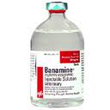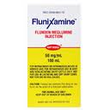Pronunciation
flu-NIKS-en meg-loo-MEEN - Pronunciation guide
Brand Names
- Banamine Injectable Solution
- Banamine Paste
- Flu-Nix D
- FluMeglumine
- FlunixiJect
Description
 Flunixin meglumine is a non-steroidal, anti-inflammatory drug used as a potent pain reliever, fever reducer, and anti-inflammatory in horses. It provides protection from toxins due to certain bacterial infections, and is used as an anti-inflammatory in the treatment of painful eye conditions.
Flunixin meglumine is a non-steroidal, anti-inflammatory drug used as a potent pain reliever, fever reducer, and anti-inflammatory in horses. It provides protection from toxins due to certain bacterial infections, and is used as an anti-inflammatory in the treatment of painful eye conditions.
Flunixin meglumine works by inhibiting the body's production of prostaglandins and other chemicals that stimulate the body's inflammatory response. This drug works quickly, with pain relief and fever reduction usually starting within one to two hours.
Usage
Flunixin meglumine is used in the treatment of colic and other gastrointestinal diseases for pain relief and for protection from toxins due to endotoxemia. As an NSAID, it provides symptomatic relief by lowering fever, but does not treat the underlying infection.
Flunixin meglumine has a rapid onset of action and is the agent of choice in the initial treatment of tendonitis and many musculosketetal injuries. Under the brand name Banamine, it is known as a cyclo-oxygenase inhibitor and prevents the unwanted circulatory and vascular effects of bacterial endotoxins. It is used in the treatment of endotoxemia associated with acute laminitis, acute colitis, and acute septic metritis.
Flunixin meglumine is used as an anti-inflammatory in the treatment of many painful eye conditions.
Dosage and Administration
 Flunixin Meglumine Flunixin Meglumine |
||||
|---|---|---|---|---|
| Method | Dosage (click row for calculator) |
Concentration | Period | Duration |
| Oral | 0.5 mg/lb | 1500 mg/syringe | Daily | Up to 5 days |
| Intravenous or Intramuscular injection2 | 0.5 mg/lb | 50 mg/ml | Daily | Up to 5 days |
Notes:
|
||||
Side Effects
Ulcers, especially of the stomach and large colon, are the most common side effect. Rare side effects include kidney damage and bleeding disorders.
Precautions
Flunixin meglumine may be given IM, but injection site reactions, including localized pain, swelling, and muscle inflammation or damage, sometimes occur. Allergic reactions have been reported, but are rare. It should be avoided or carefully monitored in horses with liver disease, kidney disease, or other gastrointestinal problems.
Some veterinarians believe that flunixin meglumine is powerful enough that it can mask colic pain, making decisions regarding surgery more difficult.
Flunixin meglumine should be used with caution in foals and older horses, especially those with a tendency toward ulcers or impaired liver or kidney function.
Flunixin is FDA approved for use in horses and is a prescription drug restricted to use by or on the lawful written or oral order of a licensed veterinarian.
Flunixin meglumine is either a regulated or prohibited substance in most sanctioned competitions. It is important to check with the individual regulatory group for rules and regulations.
Interactions
Flunixin meglumine should not be combined with other anti-inflammatory drugs that tend to cause ulcers, such as other NSAIDs and corticosteroids. It should be used with caution with aminoglycoside antibiotics and oral anticoagulants, such as warfarin.
Overdose
Experimentally, it has taken three to five times the normal dose over multiple days to produce toxicity.
Images
 Banamine Injection
Banamine Injection
 Flunixamine
Flunixamine
Literature
